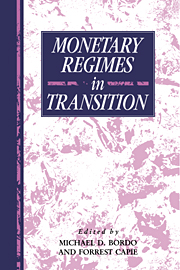Book contents
- Frontmatter
- Contents
- List of figures
- List of tables
- List of contributors
- 1 Introduction
- Part I Commodity money standards in transition
- Part II Successful and unsuccessful adherence to the gold standard
- 5 Spain during the classical gold standard years, 1880–1914
- 6 Canada and the gold standard, 1871–1914: a durable monetary regime
- 7 Australia's payments adjustment and capital flows under the international gold standard, 1870–1913
- Part III Wartime upheaval and postwar stabilization
- Part IV Perspectives on monetary regimes
- Index
5 - Spain during the classical gold standard years, 1880–1914
Published online by Cambridge University Press: 05 May 2010
- Frontmatter
- Contents
- List of figures
- List of tables
- List of contributors
- 1 Introduction
- Part I Commodity money standards in transition
- Part II Successful and unsuccessful adherence to the gold standard
- 5 Spain during the classical gold standard years, 1880–1914
- 6 Canada and the gold standard, 1871–1914: a durable monetary regime
- 7 Australia's payments adjustment and capital flows under the international gold standard, 1870–1913
- Part III Wartime upheaval and postwar stabilization
- Part IV Perspectives on monetary regimes
- Index
Summary
Introduction
The last quarter of the nineteenth century saw the spread of an international monetary system based on gold, linking the economy of the major countries of the world with fixed exchange rates for their domestic currencies. The gold standard offered a common solution to the monetary problems of the period and provided a relatively stable financial framework for economic growth. As Eichengreen (1985) put it, the appeal of the system can be traced to the belief that it provided price, income and exchange stability and an automatic mechanism to correct balance of payments disequilibria. The gold standard would reduce the risks associated with international trade and investment and would promote domestic specialization and long-term planning, thus contributing to the attainment of higher growth rates. The adherence of almost all countries of the international economy could be taken as the most apparent proof that the system had some considerable virtues. To remain outside the gold standard was at least unwise, unless major forces had proved that its adoption would have been catastrophic for the development of the national economy, or that policy makers had tried to avoid the presumed burden of the system and decided to manage an independent monetary policy in order to promote economic growth. To be off the gold standard meant implicitly to opt for a certain isolation and a loose intergration with the international economy.
The Spanish case appears in striking contrast with the international experience. Spain never adopted the gold standard. Convertibility of paper money into gold and/or silver was maintained until 1883, when eventually it was suspended.
- Type
- Chapter
- Information
- Monetary Regimes in Transition , pp. 135 - 172Publisher: Cambridge University PressPrint publication year: 1993
- 9
- Cited by



